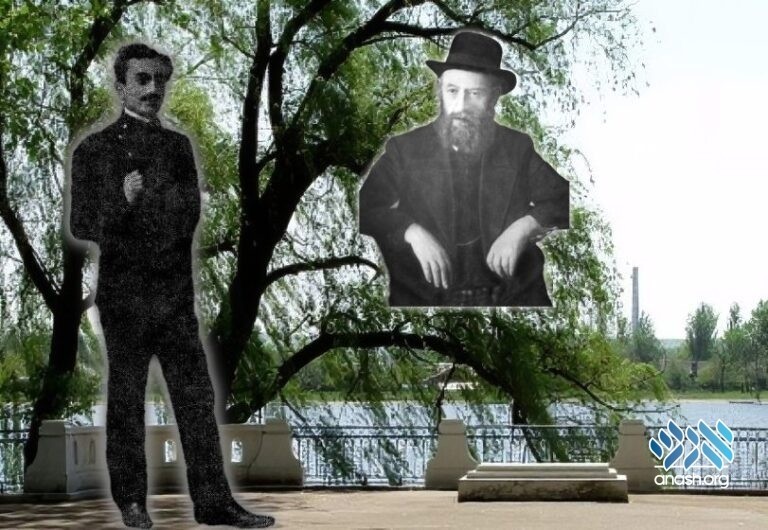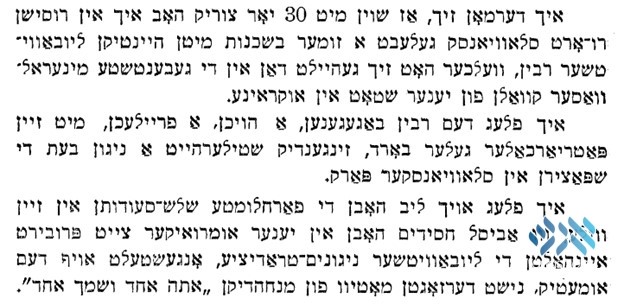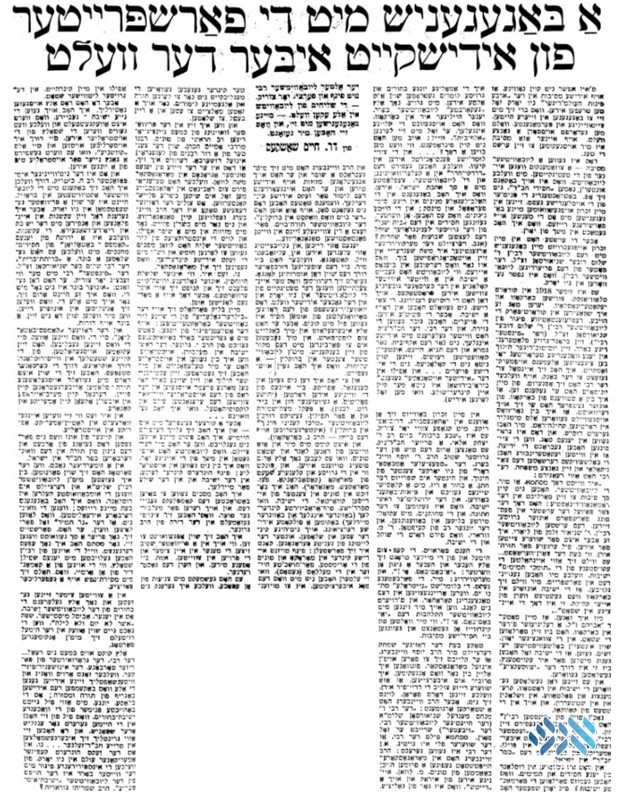Journalist Dr. Chaim Shoskes records an encounter he had with the Rebbe Rashab in the resort town of Sloviansk and the fascinating conversation they had after the Czar was killed.
By Shmuel Super
Dr. Chaim (Henry) Shoskes (1891-1964) was born in Bialystok to a frum family. At age 17, he pursued a secular education in Charkov and also served on the local Jewish community council. He later returned to Poland where he served in prominent positions in Warsaw community organizations. After the Nazi invasion, Dr. Shoskes was able to flee Warsaw and reach the U.S., where he worked to raise awareness of the extermination of Eastern European Jewry.
In the U.S., Dr. Shoskes was a contributor to the Tog Morgen Zhurnal. He traveled across the world visiting Jewish communities, from behind the Iron Curtain to hostile Arab countries, and wrote popular Yiddish feature articles and books with his observations of Jewish life there.
In the February 3 1963 edition of the Tog Morgen Zhurnal, Dr. Shoskes wrote an article about the worldwide activities of Lubavitch, as he had encountered them over the course of his travels. Shoskes describes the Chassidim he met behind the Iron Curtain, and his impressions from Chabad’s activities and influence in South Africa, Madagascar, Senegal, Congo, Melbourne, and Rio de Janeiro.
The entire article is interesting for the glimpse it give us into Chabad activities and shlichus in the early years, but the most interesting part of the article is its opening, recounting the story of Shoskes’s first encounter with Lubavitch. Here it is, in English translation:
My first memory [of Lubavitch] is of my encounter with the Lubavitcher Rebbe, Rabbi Shalom Ber Schneersohn, the father of the previous Rebbe who passed away in New York.
It was during the summer of 1918, in the resort town of Sloviansk, located between Charkov and Yekatrinoslav.
Every day I would see the tall impressive figure of Rabbi Shalom Ber of blessed memory (the “fifth Rebbe”), walking in the resort’s park. His wavy light-colored graying beard, and his Yom Tovdike walking posture during those ordinary terrifying days grabbed everyone’s attention.
I once sat down on the bench on which the Rebbe was resting. He could see from my uniform that I was a student from Charkov. From our conversation he learned that I had just been elected as a member of the community council of Charkov. We spoke in Russian. This was on the day that the newspapers brought the news that in faraway Yekaterinburg the Bolsheviks had shot Czar Nikolai and his whole family.
The Rebbe reacted to the news as follows: “You probably know that we, the Lubavitchers, don’t have too many reasons to love the Romanov dynasty. Paul I the first imprisoned our illustrious ancestor, the first Lubavitcher Rebbe, Rabbi Shneur Zalman of Liadi.
“But now I see difficult times approaching for the Jews, especially for Torah observant Jews, worse than during czarist rule. I want to preserve the Tomchei Temimim yeshivos that we have established and spread. I would like to believe that our Yeshivah in Charkov will be supported by your community, as it is the only one in the city.”
Sloviansk was a resort town that provided treatments and baths using minerals from the nearby lakes. The Rebbe Rashab visited Sloviansk a number of times for health reasons during the period in which he lived in Rostov. His 1918 (5678) summer stay in Sloviansk was from 4 Tammuz until 10 Elul (see Toldos Chabad Berusia Hatzaris, p. 316). The historical event Shoskes mentions, the murder of the Romanov family, occurred on 8 Av (July 16-17), so his conversation with the Rebbe Rashab would have taken place in the following days.
Shoskes relates further details about his time with the Rebbe Rashab in his autobiography, A Velt vos iz Farbay, p. 328 (credit to Mendel Nemanov for pointing me to this source). Writing in 1949, he mentions “the current Lubavitcher Rebbe,” but it is clear that he in fact means the Rebbe Rashab. The precise meaning of the last sentence in this account is unclear. Here is the account:
I recall how 30 years ago I spent a summer in the Russian resort town of Sloviansk, next door to the current Lubavitcher Rebbe who was recuperating in the blessed mineral waters of that Ukrainian town.
I would encounter the Rebbe, a tall, happy man, with a patriarchal light-colored beard, softly singing a niggun while walking in the park of Sloviansk.
I also loved the soothing shalosh seudos in his residence, where during that restive time a few Chassidim would try maintain the Lubavitch tradition of nigunim, based on the doleful, unrealized motif from the minchadik “atah echad veshimcha echad.”
Yet a third detailed mention of Shoskes and the Rebbe Rashab comes up in Reb Yudel Chitrik’s zichronos, published in Reshimos Devarim, p. 368. Reb Yudel apparently met Shoskes at some point and heard his impressions of the Rebbe Rashab, although he misrecords the year of the encounter as 5676.
The writer Dr. Chaim Halevi Shoskes related that he saw the Rebbe in Sloviansk in the summer of 5676 while he was walking with a walking stick in his hand, and the Rebbe appeared to him like a king in all of his glory. The Dr. was very impressed, and said “I saw a king walking.”
The Shoskes article we began with opened with his encounter with the Lubavitcher Rebbe in the Russian summer of 5678, and it concludes with Shoskes’s description of his encounter with the Lubavitcher Rebbe on a Brooklyn summer night decades later.
On a summer night, after dawn had already broken, I sat with the Lubavitcher Rebbe shlita and told him about the unsung heroes in Russia, whom I encountered during my travels, those remarkable idealists who do not allow the eternal light to be extinguished. He already knew much about them, of course, but I probably added something new, because his eyes shone with the silent pride of a general whose army is persevering in a terrible situation with mesiras nefesh.
Shoskes also maintained a correspondence with the Rebbe, with letters from the Rebbe to him published in Igros Kodesh, vol. 14, p. 322 (referencing what seems to have been their first meeting in 5717); vol. 20, p. 34; and vol. 22, p. 219. In these letters, the Rebbe addresses the purpose of the Jewish people’s dispersal in galus across the world, and encourages Shoskes to utilize his travels to encourage the Jews he meets and strengthen their connections with their fellow Jews and with Torah.



Discussion
We appreciate your feedback. If you have any additional information to contribute to this article, it will be added below.